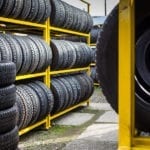Driving in the winter can obviously be difficult, but the cold season in northern parts of the U.S. has been relatively mild over the past couple of decades (excluding the wild winter we’re all still recovering from, of course). For example, the city of Cincinnati averages just under 10 days of snowfall annually, which ultimately accumulates to about 11.2 inches of snow a year. No problem, right? If you live in New England, you could easily surpass that total in a 24-hour period.
So, based on those numbers, you don’t need winter tires to get around Cincinnati, right? Wrong. Winter tires are still essential, and Cincinnati’s lack of snow doesn’t exclude the city from that sentiment.
Besides, even if there was no snow and no hills, winter tires would still be the logical choice. The rubber compound found in winter tires are supposed to retain more grip when the temperature drops. Therefore, the tires are useful in cold, dry conditions… not just cold, wet conditions. Considering it can still drop below freezing in Cincinnati, this fact is certainly applicable.
So if you’re debating whether you should be replacing your current tires once the summer ends, read the post below to get a better understanding of the advantages. Then, when you’re finally searching for tires in Cincinnati, you’ll know exactly what to look for…
Gone are the winters of the 1980s, when rear-wheel drive vehicles struggled to get up the steep hills of Cincinnati. Now we have front-wheel drive vehicles, allowing the weight of the drivetrain to assists the wheels that need the most traction. Still, there’s no guarantee that these front-wheel drive tires will provide you with the necessary traction.
This traction is essential, whether the conditions are snowy, icy or dry. As long as it’s cold outside, you’ll be relying on your tire’s physical resistance more than usual.
Some people assume that all-season tires will do the trick, and they aren’t necessarily mistaken. However, there aren’t many drivers out there buying all-season tires during the winter. Even if you’ve been riding on those wheels for less than a year, there’s a good chance the tread is starting to wear. Sure, you could make it through a single winter, but you’ll likely face some issues if you try these tires for a second straight year.
Besides the superior traction, why else are winter tires better for driving in cold weather? They provide added control, which is important when the roads start to freeze over, and this will vicariously allow for better braking (which, if you’ve ever driven in the winter, is especially important). The softer rubber results in a deeper tread, and you can even maximize your traction by adding hard studs. This will allow the tires to dig into the snow and ice better than all-season tires, and you’ll instantly feel the result when you’re driving.
You may be thinking that you’re all set with your four-wheel drive vehicle, and there’s no denying that it certainly helps. However, your vehicle should still have winter tires. The all-wheel drive will increase your ability to accelerate on cold, snowy or icy roads, but it doesn’t assist with the braking. This could actually cause greater damage. If a driver is convinced they can go faster on all-wheel drive, they’ll like accelerate… but they’ll likely fail to remember the car’s inability to brake properly in these bad conditions.
It’s better to be safe than sorry. Considering the number of hills in Cincinnati (and considering the city’s apparent inability to clear the roads in a timely fashion), you may find yourself struggling to drive on a miserable day. Sure, the winters may be relatively quiet compared to other areas of the city, but one snow storm could potentially leave you stranded. In other words, you’ll have a very difficult time traveling around a cold or snowy Cincinnati without snow tires.
Whatever you do, make sure you don’t mix winter tires with all-season tires. If you don’t want to opt for winter accessories, all the power to you, but make sure you don’t mix and match. Driving on different types of tires will make you more prone to spinning out or crashing. Depending on your (non-recommended) configuration, you may even find yourself struggling to turn. There’s a reason why you usually have all four tires changed, not one. While you may be saving yourself a couple of bucks, you could ultimately pay a bigger price if you get in an accident. This lesson also applies to rear-wheel or front-wheel drive vehicles.
If you’re still apprehensive, I’d suggest buying a pair of snow tires and storing them. That way you’ll be ready for whenever the need arises. When it comes to tips for storing tires, make sure you keep them in a cool place where they’re out of direct sunlight. You’ll want to clean off the tires (if they’ve been used), but make sure you do not use tire dressings. Each individual tire should be stored in it’s own airtight plastic bag, which will prevent moisture from getting in and air from getting out.
The best time to purchase winter tires is during the late summer or early fall, which should give you a large window of time before the bad weather hits. This will also help you avoid the last-minute rush. Stay on top of the weather reports, and anticipate when the first snowfall or cold front will come through the city. Driving around on dry pavement for a couple of weeks won’t do any harm to your tires, so it’s better off to be proactive. You can keep this lesson in mind towards the end of the winter, as well. Even if the weather is starting to warm up, don’t switch to those summer tires until you’re convinced the snow, ice and cold are done with.
If you can’t afford new tires, what should you do? Certainly don’t risk it and go driving in horrible conditions. Luckily, Cincinnati has an excellent public transportation system, and the bus should be able to get you wherever you need to go. You know your car best, so if you are skeptical about your cars and tires completing a trip, take that as a sign that you should give your vehicle a day off. Accidents can be expensive, and a bus ticket will only cost you a couple of bucks. If you want to be very prepared, purchase a Stored-Value Card, which are available in $10, $20 and $30 quantities. The cards don’t expire, so you should never have an excuse to risk your car and ignore the bus.
So, as you’ve read above, it’s a good idea to go with winter tires during the winter. Reversely, it’s also a good idea to have a set of summer tires. All-season tires were produced so drivers didn’t have to change their tires following each season. As a result, these tires are adequate at most functions, combining the attributes of a summer and winter tire. However, they don’t excel at any one thing. While your winter and summer tires would likely receive high marks for their abilities, expect all-season tires to receive average grades.
After all, it’s better to be prepared. You don’t want to increase your winter suffering with a car accident!








